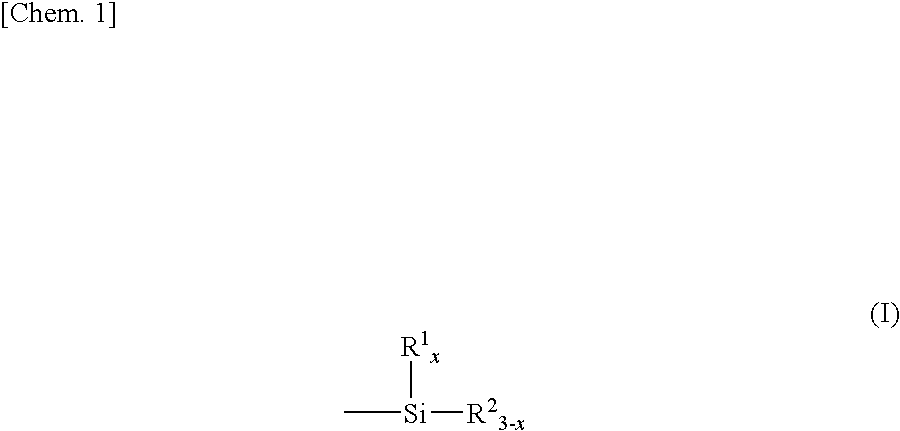Coating agent and method for production thereof
a technology of coating agent and coating film, which is applied in the direction of coatings, polyurea/polyurethane coatings, etc., can solve the problems of difficult to obtain a coating film having excellent chemical resistance, high solvent resistance or water resistance, and inability to form a high-level film. , to achieve the effect of excellent solvent resistance, excellent corrosion resistance and preventing the generation of rus
- Summary
- Abstract
- Description
- Claims
- Application Information
AI Technical Summary
Benefits of technology
Problems solved by technology
Method used
Image
Examples
reference example 1
Production of Urethane Resin (a1)-1
[0232]In a nitrogen-purged vessel equipped with a thermometer, a nitrogen gas inlet, and a stirrer, 100 parts by mass of polyester polyol (a polyester polyol obtained by reacting 1,4-cyclohexanedimethanol and neopentyl glycol with adipic acid, the content of the aliphatic cyclic structure in the polyester polyol was 1425 mmol / kg, the hydroxyl group equivalent was 1000 g / equivalent), 17.6 parts by mass of 2,2-dimethylolpropionic acid, 21.7 parts by mass of 1,4-cyclohexanedimethanol, and 106.2 parts by mass of dicyclohexylmethane diisocyanate were reacted in a mixed solvent of 59 parts by mass of methyl ethyl ketone and 119 parts by mass of N-methyl-2-pyrrolidone. Thus, an organic solvent solution of a urethane prepolymer having an isocyanate group at the molecule end was obtained.
[0233]Subsequently, 13 parts by mass of triethylamine was added to the organic solvent solution of the urethane resin to partially or completely neutralize the carboxyl gro...
reference example 2
Production of Urethane Resin (a1)-2
[0235]In a nitrogen-purged vessel equipped with a thermometer, a nitrogen gas inlet, and a stirrer, 100 parts by mass of polyester polyol (a polyester polyol obtained by reacting 1,4-cyclohexanedimethanol and neopentyl glycol with adipic acid, the content of the aliphatic cyclic structure in the polyester polyol was 1425 mmol / kg, the hydroxyl group equivalent was 1000 g / equivalent), 17.6 parts by mass of 2,2-dimethylolpropionic acid, 21.7 parts by mass of 1,4-cyclohexanedimethanol, and 106.2 parts by mass of dicyclohexylmethane diisocyanate were reacted in a mixed solvent of 59 parts by mass of methyl ethyl ketone and 119 parts by mass of N-methyl-2-pyrrolidone. Thus, an organic solvent solution of a urethane prepolymer having an isocyanate group at the molecule end was obtained.
[0236]Subsequently, 10 parts by mass of γ-aminopropyltriethoxysilane was mixed with the organic solvent solution of the urethane prepolymer, and the urethane prepolymer was...
reference example 3
Production of Urethane Resin (a1)-3
[0239]In a nitrogen-purged vessel equipped with a thermometer, a nitrogen gas inlet, and a stirrer, 100 parts by mass of polyester polyol (a polyester polyol obtained by reacting neopentyl glycol and 1,6-hexanediol with adipic acid, the hydroxyl group equivalent was 1000 g / equivalent), 17.6 parts by mass of 2,2-dimethylolpropionic acid, 21.7 parts by mass of 1,4-cyclohexanedimethanol, and 106.2 parts by mass of dicyclohexylmethane diisocyanate were reacted in a mixed solvent of 59 parts by mass of methyl ethyl ketone and 119 parts by mass of N-methyl-2-pyrrolidone. Thus, an organic solvent solution of a urethane prepolymer having an isocyanate group at the molecule end was obtained.
[0240]Subsequently, 13 parts by mass of triethylamine was added to the organic solvent solution of the urethane resin to partially or completely neutralize the carboxyl groups carried by the urethane resin. 375 parts by mass of water was further added and the mixture was...
PUM
| Property | Measurement | Unit |
|---|---|---|
| Molality | aaaaa | aaaaa |
| Molality | aaaaa | aaaaa |
| Temperature | aaaaa | aaaaa |
Abstract
Description
Claims
Application Information
 Login to View More
Login to View More - R&D
- Intellectual Property
- Life Sciences
- Materials
- Tech Scout
- Unparalleled Data Quality
- Higher Quality Content
- 60% Fewer Hallucinations
Browse by: Latest US Patents, China's latest patents, Technical Efficacy Thesaurus, Application Domain, Technology Topic, Popular Technical Reports.
© 2025 PatSnap. All rights reserved.Legal|Privacy policy|Modern Slavery Act Transparency Statement|Sitemap|About US| Contact US: help@patsnap.com

